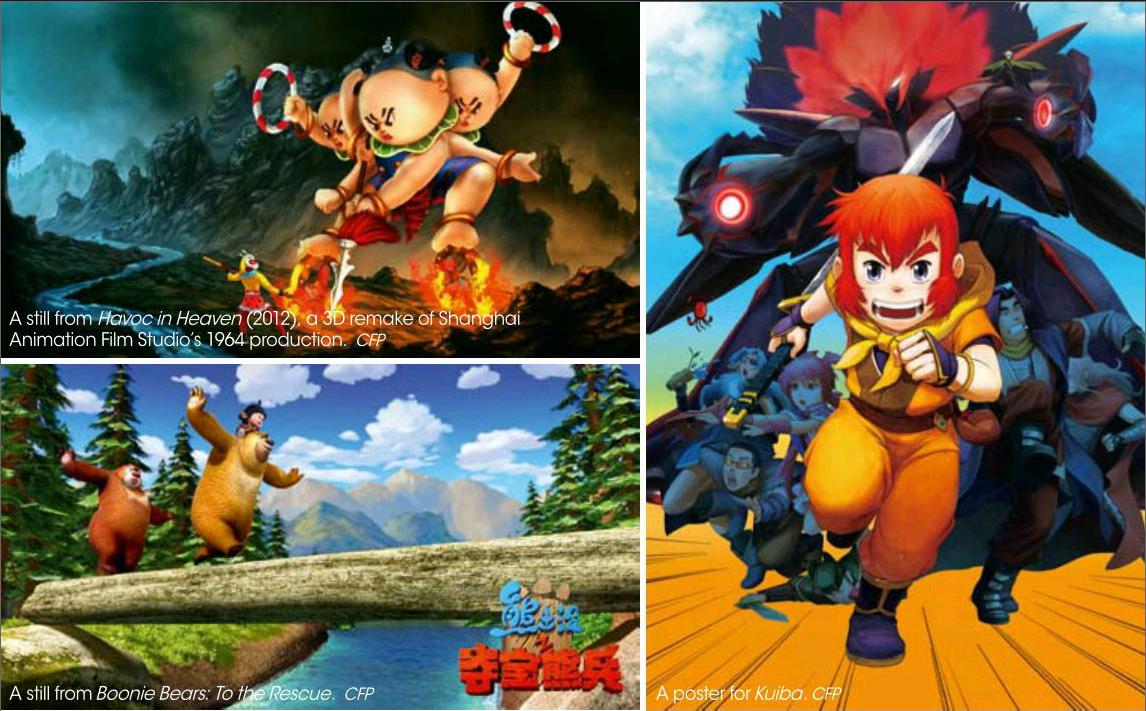Drawing the Curtain
by+Liu+Haile

Early this year, the 3D Chinese animated film, Boonie Bears: To the Rescue, raked in more than 200 million yuan at the box office to become the most successful Chinese animation ever. The figure is comparable to the Chinese mainland earnings of American cartoon Despicable Me 2 that ran during the same period. Industry insiders consider the success a “giant leap” for Chinese animators and a more mature 3D industrial chain. However, a long road remains for Chinas animation industry if it intends to catch up with Hollywood.
Road to Market
Actually, Chinas animation industry didnt start exceptionally late. In 1926, Chinese filmmaker Wan Laiming and his brothers produced the countrys first animated short, Uproar in the Studio. In the 1940s, the Wan brothers produced Chinas first animated feature, Princess Iron-Fan, during the same era Disney released its first animated feature, Snow White and the Seven Dwarfs.
After the founding of the Peoples Republic of China in 1949, the Shanghai Animation Film Studio was established, which led to animation booms in the 1960s and 80s. During these periods, a number of excellent animated movies such as Havoc in Heaven and Nezha Conquers the Dragon King were produced. In the era when Chinas economy was planned, all animated productions were purchased by and distributed through the government, and animators didnt worry about box office performance. In the late 1980s, China opened its animation market, and American and Japanese productions began to swarm into the country. When the government abruptly stopped purchasing films, Chinese animation plunged into a “dark age.”
In 2005, China enacted policies to limit the proportion of imported animation on Chinese television, inspiring greater demand for domestic productions. “After the policy was implemented, domestic animation represented by Pleasant Goat and Big Big Wolf seized the opportunity to achieve remarkable market success,”comments Sun Lijun, dean of the School of Animation at Beijing Film Academy. “The Boonie Bears series followed the same path: Build brand awareness through television animation and then hit the theaters. In terms of animation technology, the latters 3D is better than the formers 2D. Moreover, the latters business mode is more mature.”
Still Lagging Behind
Currently, China annually produces more than 4,000 hours of animation and has surpassed Japan to become the worlds biggest animation producer. However, domestic animation still lags behind American and Japanese productions in terms of quality, originality, and marketability to some degree.
In recent years, a handful of Chinese animated features such as Legend of a Rabbit and Kuiba won acclaim from both critics and spectators, but none achieved a market success. Reality is cruel: Chinese animation must face both rivalry from imported animation and discrimination of moviegoers.
“The biggest problem plaguing Chinese animation is lack of brand awareness,” opines Sun Lijun. “The audience has formed a mindset that domestic animated productions are not attractive, and then theater operators tend to concur. Domestic animation is often screened in so-called ‘garbage time slots such as mornings and early afternoons, when children are at school and their parents at work. How can they expect massive box office earnings?”
Usually, Hollywood animation like Frozen and the Shrek series targets audiences of various ages, but the plots of most domestic productions are only appealing to young children. Disney frequently casts veteran comedians in voice roles and peppers its scripts with refined humor aimed at adults, which flies over kidsheads. According to Sun, preschoolers are currently the major target demographic for domestic animators. To optimize market success, however, a film must be attractive to as many moviegoers as possible. Market analysts believe that one factor behind the success of Boonie Bears: To the Rescue is the films appeal to all ages. Compared to its predecessor that targeted spectators between ages six and eight, Legend of a Rabbit 2 expanded its appeal to children between six and 12.
Additionally, Chinas animation industry lags behind its American and Japanese counterparts in terms of originality. Both Chinese investors and animators lack patience and fortitude to create original productions, and are more inclined to mimic successful American and Japanese animation. The Chinese government has provided incentives such as subsidies for domestic animated productions, but compared to each years tremendous output, the subsidy for each project is very limited. “The government should focus on encouraging really original and quality productions,”remarks Sun Lijun.
Future
Despite the various challenges it faces, Chinas animation industry has still witnessed rapid growth as the countrys film market continues expanding quickly. In 2013, domestic animation achieved box office revenues of 628 million yuan, up 57 percent over the previous year.
Chinas expanding animation market has drawn attention from major domestic film studios. Last year, Huayi Brothers Media Group, Chinas biggest film studio, became a partner of Creative Power Entertaining Co., Ltd., the producer of Pleasant Goat and Big Big Wolf series. Beijing Enlight Pictures Co., Ltd. began distributing the animated film Seer III: Heroes Alliance. Beijing Galloping Horse Media Co., Ltd. became a co-producer of Happy Heroes. Almost overnight, once-ignored Chinese animation became desirable for Chinese film tycoons.
“The animation market couldnt attract heavyweight investors until its size grew enough,” comments Liu Kexin, Chief Creative Officer of Taikong Works, the producer of the animated series Legend of the Moles. “In the past, Chinas animation film market was too small to draw attention from large companies.”
“Chinas animation industry must follow a path toward commercialization and marketization,” declares Sun Lijun. “The country has 375 million children, and thats an enormous market. The audiences mindset on domestic animation may change if the countrys four satellite animation television channels take the responsibility to cultivate the audiences taste, so that Chinese animation films can stand on their own.”
As for the future of Chinas animation industry, Liu Kexin predicts that it will enter a period of brand integration in next few years. “Large animation companies will build their own brands, pushing the industry into an era of brand recognition.”

